Last updated on April 17th, 2024
The Sun formed 4.6 billion years ago in a giant, spinning cloud of gas and dust called the solar nebula, that originated from the explosion of another star in the Milky Way. It was formed when gravity concentrated 99.8% of the gas and dust in the solar nebula. The rest of the material created the planets and other objects that orbit the Sun. Helios is the Greek god that personifies the Sun. Nowadays, the prefix or suffix “helio“ are used to form words related to the Sun, for example heliocentric (having the Sun as centre) or perihelion (the point nearest to the Sun in a celestial body’s orbit around it).
Interesting facts about the Sun
1. The science of studying the Sun and its influence in the Solar System is called “heliophysics”. “Helio-” refers to the Sun, and “-physics” to the study of matter, energy, and their interaction.
2. Although the Sun is extremely big, there are other stars in the Universe that are even larger. UY Scuti, in the Scutum Constellation, is 1,708 times wider than the Sun, and is the largest star known to date.
3. The Sun does not only emit visible light, it also generates ultraviolet light, infrared, radio waves, X-rays, and gamma-rays. The energy from the Sun makes life possible on Earth.
4. The hottest part of the Sun is its core (15 million °C). Surprisingly, the following hottest part of the Sun is its corona and not its surface, the photosphere, which has an average temperature of 5,500 °C.
5. The Sun orbits the centre of the Milky Way, carrying the rest of the Solar System (planets, asteroids, comets) with it.
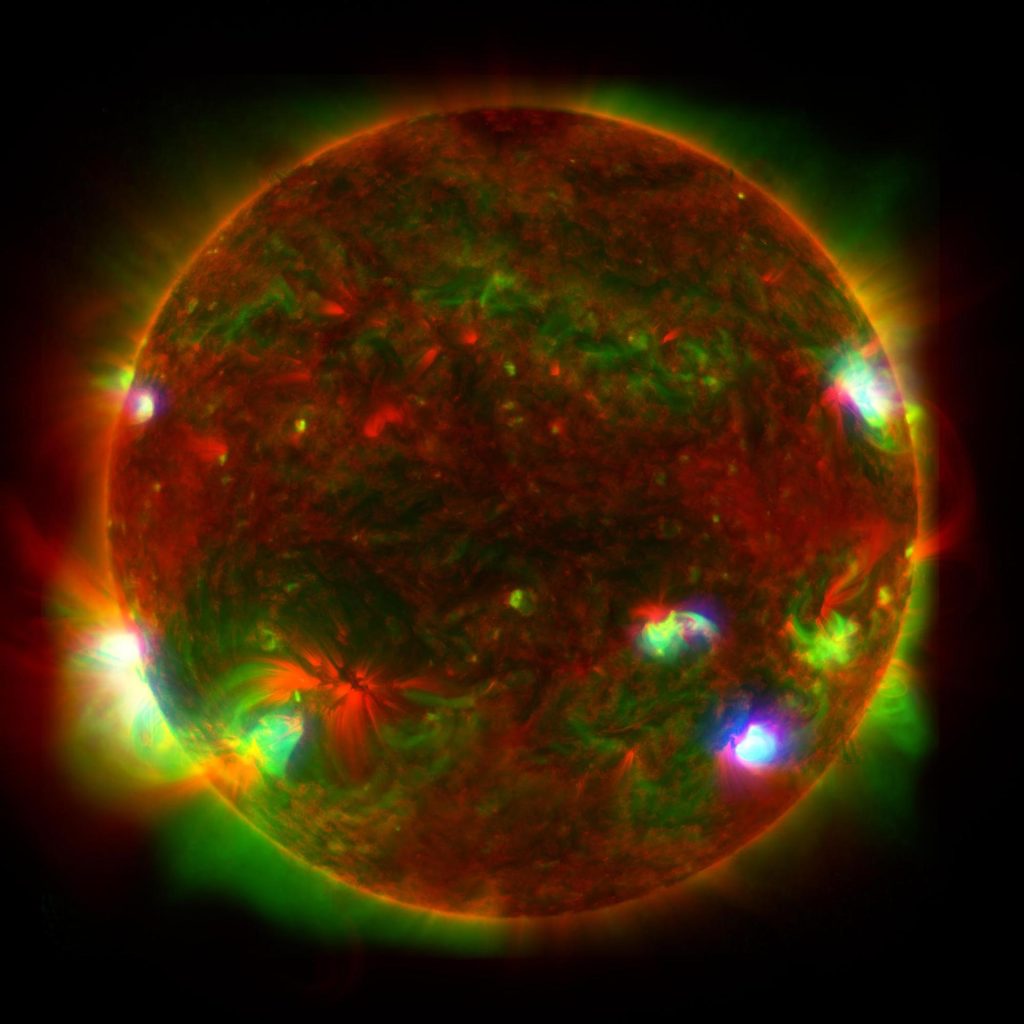
6. The Sun rotates on its axis, but as it is not solid, the equator spins faster than the poles. The equator completes one rotation in 25 Earth days, while the poles take 36 Earth days.
7. There are several dust rings circling the Sun, tracing the orbits of the planets. They could be remnants of the dust and gas that surrounded the Sun when the Solar System was formed.
The Sun is a giant ball of hydrogen and helium held together by gravity.
Solar flares – when, what, and why?
8. Solar flares are created when the magnetic field lines near sunspots tangle, cross, and reorganise. This generates an explosion of energy, and gas erupts and shoots up from the Sun’s surface.
9. Solar flares on the Sun’s surface are sudden explosions of energy. They release a lot of radiation into space, which can affect communications on Earth.
10. Solar flares are sometimes accompanied by coronal mass ejections, which are large bubbles of radiation and particles ejected from the Sun’s corona.
11. A solar radiation storm happens when a large-scale magnetic eruption on the Sun, often causing coronal mass ejections and solar flares, accelerates charged particles. These particles can reach the Earth in 10s of minutes, and penetrate into the atmosphere near the poles.
12. When an extreme solar storm happens, passengers and crew in high flying aircrafts may be exposed to higher radiation levels.
13. The Sun has regular cycles of high and low activity. Each solar cycle lasts approximately 11 years, and can be tracked by observing the sunspots on the Sun’s atmosphere.
14. During the period of high solar activity there is an increase in solar storms, sunspots, solar flares, and coronal mass ejections.
15. Record keeping of solar cycles of high and low activity started in 1755. We are currently in Solar Cycle 25, which started with a period of low activity in December 2019. The predicted period of maximum activity should occur in July 2025.
16. An increase in solar activity can affect communications on Earth, interfering with satellites, and radio communications. It can also affect power grids, and corrode pipelines. In December 2006, solar flares disrupted the GPS signals for about 10 minutes.
17. The Sun has a massive magnetosphere that reaches the end of the Solar System. It is carried by the solar wind (electrically charged gas blowing from the Sun).
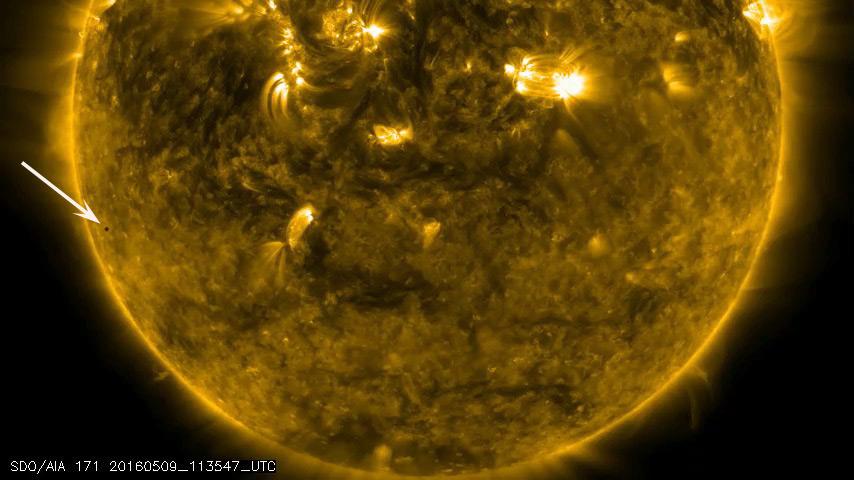
18. When the Sun starts to deplete its hydrogen, it will swell and become a Red Giant that will swallow the inner planets. It will then lose the outer layers, and the inner ones will shrink to become a White Dwarf. This process will start in about 5 billion years.
19. A solar eclipse happens when the Sun, the Moon, and the Earth align, and the Moon covers the disc of the Sun blocking its view. During a total solar eclipse, the coverage of the whole solar disc lasts two to three minutes.
20. Solar eclipses are less common than lunar eclipses. This is because to see a solar eclipse the observer needs to be in the right place at the right time, whereas a lunar eclipse is visible from any location where the Moon is above the horizon.
21. As the Moon moves farther away from Earth, total solar eclipses (the alignment of the Sun, Moon, and Earth) will eventually stop happening. In about 600 million years the Moon would have moved so much, that only partial solar eclipses will be seen.
The first record of a total solar eclipse is in a clay tablet found in the ancient city of Ugarit, in what is now known as Syria. It registers a total solar eclipse that may have happened on 5 March 1223 BC.
22. The spectrum of light generated by the Sun is not entirely continuous from red to violet, it has dark lines that correspond to the absorption lines of the different elements present in the Sun. The position and intensity of these dark lines are used to identify and quantify those elements.
23. The first picture of the Sun (from which evidence is available) was a daguerreotype, a direct-positive that creates an image on a sheet of copper plated with silver. It was taken in 1845 by the French physicists Armand Hippolyte Louis Fizeau and Jean Bernard Léon Foucault.
24. The Daniel K. Inouye Solar Telescope based in Hawaii has produced the highest resolution images of the Sun’s surface ever taken. The pictures and videos were released in 2020, and show cell-like structures, a pattern of turbulent boiling gas moving violently on the surface.
The first spacecraft to orbit the Sun was Pioneer 5 in 1960, and the first spacecraft to fly though the Sun’s corona was the Parker Solar Probe in 2021.
Culture and myth about the Sun
25. Many ancient cultures worshiped the sun as a deity (Egyptian, Indo-European, and Meso-American.)
26. A scientist and philosopher from modern-day Turkey called Anaxagoras was the first to suggest that the sun is a star, around 450 BC.
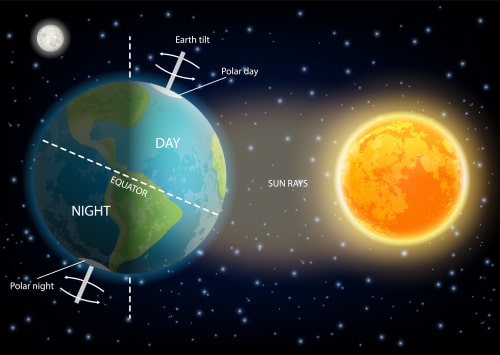
27. Our modern day calendar is based on the earth’s movement around the sun.
28. It is a relatively young star, part of a generation known as Population I.
29. It is about halfway through its lifetime.
Facts about its size
30. You can fit 1.3 million earths into it.
31. It is the largest object in the solar system.
32. Its mass is 333,000 times that of the earth.
33. It occupies about 99.86 percent of the total mass of the solar system.
34. The Sun is the largest body in the Solar System. It is almost 100 times as wide as the Earth, and 10 times as wide as Jupiter (the largest planet in the Solar System).
10 most common elements in the sun
| Serial | Element | Abundance (pct. of total number of atoms) | Abundance (pct. of total mass) |
|---|---|---|---|
| 1. | Hydrogen | 91.2 | 71.0 |
| 2. | Helium | 8.7 | 27.1 |
| 3. | Oxygen | 0.078 | 0.97 |
| 4. | Carbon | 0.043 | 0.40 |
| 5. | Nitrogen | 0.0088 | 0.096 |
| 6. | Silicon | 0.0045 | 0.099 |
| 7. | Magnesium | 0.0038 | 0.076 |
| 8. | Neon | 0.0035 | 0.058 |
| 9. | Iron | 0.030 | 0.014 |
| 10. | Sulfur | 0.015 | 0.040 |
Facts about the distance of Sun from Earth
35. It is closer to earth than all other stars.
36. It is approximately 391 times as far away from earth as the moon.
37. Its distance from the earth changes at different points during the year.
38. It is 30,000 light years away from the center of The Milky Way.
39. Light from the sun takes eight minutes and twenty seconds to reach the earth.
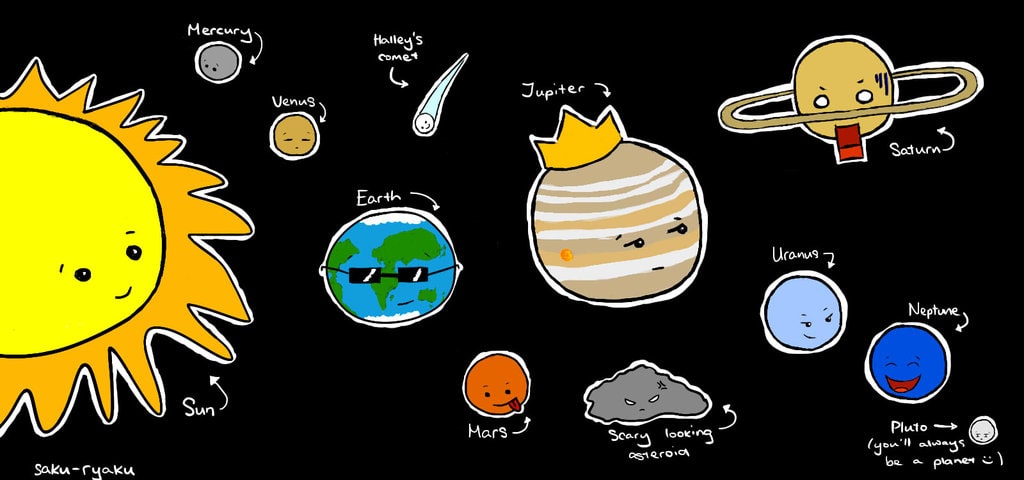
40. The sun’s gravity anchors earth and all the other planets together in a small space called the solar system. If the sun weren’t there, the earth would travel in a straight line.
41. Its gravity is 28 times stronger than earth’s gravity.
42. The bubble that surrounds the sun and solar system is called the heliosphere.
43. Helioseismology is the study of the interior of the sun.
44. The sun is studied using many satellites, the main one being the SOHO (Solar and Heliospheric Observatory)
45. One million earths would make up 0.00033% of all the stars in the Milky Way.
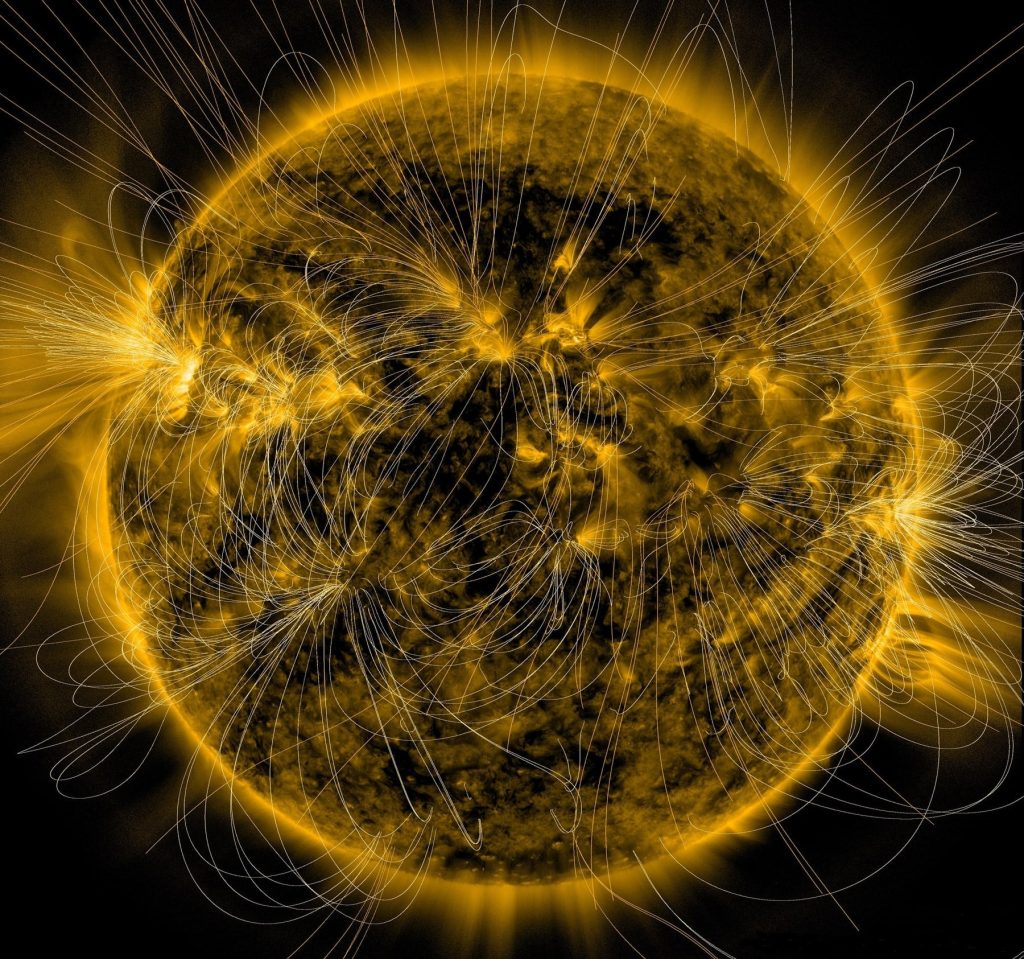
Facts about Sun’s energy
46. There are electric currents inside of it that generate a magnetic field which spreads throughout the solar system.
47. A geomagnetic storm is a worldwide disturbance of the earth’s magnetic field as a result of solar activity.
48. The sun produces energy that supports all life on earth through a process known as photosynthesis.
49. Nuclear reactions occur within the core of the sun, due to its temperature and pressure.
50. The energy within the Sun is generated by atomic fusion. Four atoms of hydrogen fuse together to form helium, releasing energy. Fusion also causes the loss of mass and aging of the Sun. When all the hydrogen in the core is consumed, the Sun will start to cool.
51. The fusion of hydrogen atoms to form helium and generate energy within the Sun’s core, also releases a type of sub-atomic particle called a “neutrino”. Neutrinos have negligible mass, no electrical charge, and can be used, for example, to study the origin of high-energy cosmic rays.
52. The element Helium was named after the Sun. It was discovered while analysing the light spectrum from the Sun in 1868, before it was detected on Earth in 1894.
53. Helium is the second most abundant element both in the sun and in the universe, but very hard to find on earth.
54. The Sun emits three different kinds of energy; infrared radiation, visible light, and ultraviolet light.
55. The ozone layer absorbs most of the sun’s harmful ultraviolet rays which cause sun burns.
56. The suns UV rays also have antiseptic properties.
57. The process by which energy moves from the sun to the earth is known as radiation.
58. The heat and energy released from the core of the sun take a million years to reach its surface.
59. When magnetic energy that has been building up in the sun’s atmosphere is suddenly released, it causes a rapid variation in brightness known as a solar flare.
60. The amount of energy released during a flare is equivalent to a simultaneous explosion of millions of 100-megaton hydrogen bombs.
61. This explosion is ten million times greater than a volcanic eruption but less than 1/10th of the total energy emitted by the sun per second.
. . . continue reading facts about Sun on the next page
